Have you hard of ascots? Also known as a hanker-tie, they are sometimes worn as an alternative to a necktie or bow tie. Like neckties and bow ties, ascots are worn around the neck -- typically directly below the front of the shirt collar. Ascots, however, offer a more unique and traditional appearance than their necktie and bow tie counterparts.
What Is an Ascot?
An ascot is a type of informal suit accessory that's worn around the neck. They generally consist of a wide piece of cloth. Some ascots are made of silk, whereas others are made of cotton or wool. With their wide design, ascots can be wrapped around the neck in a way that's not possible with neckties or bow ties.
It's believed that ascots were originally worn by horse jockeys in England. Many years ago, jockeys would participate in a race known as the Royal Ascot. This race was unique because it required the jockeys to wear a piece of cloth wrapped around their neck. Known as an ascot, it eventually made its way into mainstream fashion where the rest was history. Today, countless men throughout the world wear an ascot in their suit outfits.
Advantages of Ascots
Ascots offer several advantages, one of which is the simple fact that they are one size fits all. You don't have to worry about accidentally buying an ascot in the wrong size. All ascots consist of a wide piece of a cloth, which you can adjust to create an appropriate fit.
You may discover that it's easier to tie an ascot than a necktie. There are over a dozen ways to tie neckties. While some of these techniques are more complex than others, they all require a fair amount of work. Ascots, however, are relatively easy to tie. You don't have to worry about creating a specific knot but, instead, you simply wrap the ascot around your neck. If you're tired of fiddling with your necktie for a half-hour or longer in the mornings, you should consider investing in an ascot.
Ascots are available in dozens of beautiful colors and patterns. There are single-colored ascots that, as the name suggests, feature a single color. However, there are also two-tone ascots that feature two colors. You can even find patterned ascots available in designs with three or more colors. Regardless, the color possibilities are endless with ascots.
Disadvantages of Ascots
On the other hand, ascots lack the formality of neckties and bow ties. If you're getting dressed for a formal event, you may want to avoid wearing an ascot. For formal events, you'll need to wear a formal suit accessory, the most common being either a necktie or a bow tie.
While ascots are often worn as an alternative to neckties and bow ties, they are considered informal. Therefore, ascots aren't appropriate for most formal events. Instead, you should choose a necktie or a bow tie with which to accessory your suit, both of which are more formal than ascots.
Ascots are also more vulnerable to wrinkles than neckties and bow ties. If you wear a necktie or a bow tie, you really don't have to worry about wrinkles. As long as the necktie or bow tie was pressed beforehand, it shouldn't develop wrinkles. Unfortunately, ascots are more susceptible to wrinkles. They are worn around the neck somewhat loosely, so over time, they tend to develop wrinkles.

How to Choose an Ascot
The secret to successfully wearing an ascot is to choose the right type for your suit outfit. If it doesn't match your suit, it will likely look awkward when worn. What type of ascot should you choose exactly?
You should choose an ascot that matches the suit with which you wear it. If you're wearing a black suit with a white button-up dress shirt, for instance, you may want to wear an all-black ascot. The black ascot will contrast with your white dress shirt. At the same time, it will also match the color of your suit, thereby creating a cohesive and stylish outfit.
Something else to look for when choosing an ascot is the material from which it's made. Silk, linen and wool are some of the most common materials used to make ascots. Silk is the softest of these three materials, making it an excellent choice for an ascot. Linen, on the other hand, is a lighter material that's ideal for the spring and summer months. Wood ascots are the heaviest, so they are typically preferred for the colder months of the year.
Of course, you can find ascots available in other materials as well. Feel free to explore some of these other materials. After all, you really won't know which material is right for you until you try it.
Finally, make sure your ascot isn't damaged or otherwise suffering from defects. Ascots are generally made of a thin material, so they are susceptible to damage. If an ascot has any form of visible damage, you shouldn't wear it. Rather, you should choose an undamaged ascot to wear with your suit outfit.
Ascots vs Neckties vs Bow Ties: Which Should I Wear?
Ascots are just one of several accessories to consider wearing with a suit. If you're aiming for a more formal appearance, you may want to choose a bow tie or a necktie. Neckties and bow ties are more formal than ascots, making them an attractive alternative. Check out this blog post for more information on the differences between bow ties and neckties.
To recap, an ascot is a type of informal suit accessory that's worn around the neck. They are available in many different colors and patterns, as well as materials, but they all serve the same basic purpose of emphasizing your neckline when worn.



